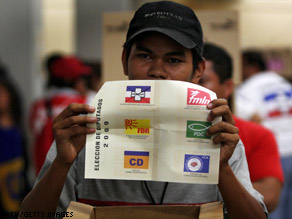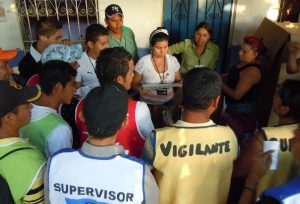Sister Cities
Sister Cities Electoral Observation Report: January 18th Elections
The Electoral Observation Delegation of U.S.-El Salvador Sister Cities in coordination with the Initiative for Social Democracy (ISD) consisted of 8 persons which included nurses, psychologists, professors, environmentalists, and sociologists. These individuals came from various cities of the United States and Sweden representing the organization Sister Cities and its 17 committees in the United States. The delegation of observers from Sister Cities and the ISD observed the elections of January 18, 2009 in the municipalities of Chalatenango, Sacacoyo, and La Libertad.
The goal of the delegation was to observe the electoral process January 18th 2009 elections in an objective, neutral, and impartial way and then to present the observations to the Supreme Electoral Tribunal and the national network of Sister Cities in the United States. We will also send a copy of the report to the Members of Congress that represent us in the United States, and the new administration of President Barack Obama, specifically the State Department.
In the first place, we want to recognize the Salvadorian population that came in massive numbers to exercise their rights and complete their civic duties. We would like to thank the members of the Municipal Electoral Boards, The Departmental Electoral Boards, the Vote Receiving Boards, and the National Police for their support and attention that they brought to our delegation.
In general terms we observed tranquil atmosphere and did not observe agression between members of the Vote Receiving Boards. However anomalies and inconsistencies due to insufficient training and irregularities may have affected the development of the election, including the results.
1. During the Voting period we observed:
a. Before the electoral event
· In the Municipality of Sacacoyo the ARENA party distributed propaganda after the official close of the campaign. On the 17th of January people were seen in ARENA clothing handing out campaign propaganda.
b. Installation and Opening
· In Chalatenango, the VotingCenteropened late, at 7:12.
· The Vote Receiving Boards were not ready to accept votes at the time the Voting Center opened for the voters.
· Vote Receiving Boards took a long time to finish marking their own votes while lines of voters stood ready to cast their ballots
· The Municipal Electoral Board failed to distribute the electoral packets in a timely manner. In Chalatenango, one Vote Receiving Board received their electoral packet at 6:45 leaving only 15 minutes to open the voting table.
· Tables and kiosks that would host the voters were set up on time.
· Many problems were observed when testing indelible ink that was to be used to mark the voters hands who had completed voting
· The system for citizens to find their correct voting tables once inside the Voting Center was not clear or simple. Distinction of which individuals were to vote at each table was unclear, and large letters indicating only the first letter of the last name confused many people.
· In Chalatenango youth groups wearing party propaganda that did not appear to have official roles of Party verseers were observed in Voting Center. These youth were not directed to leave
· In Sacacoyo, one Vote Receiving Board Member was told that she would not be able to vote before 7 am and was refused her ability to vote even with her credentials and identification. Some hours later the Board said that she was able to vote at the table saying that she had tried to exercise her right before. However this means that she had her identification card for many hours during the vote, something that is not permitted according to the electoral code. This took place at the Vote Receiving Board No.05318
- Voting Development
· Outside the Voting Centers there were computer systems helping people look up their last name and the exact voting table where they would be able to vote at the Voting Center. Many people who arrived and waited to look their name up in the computers said this system was very useful
· There were serious problems with ink visibility (indicating a citizen had already voted once) people wiped off, variations in inking system, and that the ink did not work
· There were many long lines in order to be able to vote. In one case in Chalatenango, a man was observed waiting 1.5 hours to be able to vote. These long lines complicated movement within the voting canter. Some people were forced to leave without receiving their Identification Cards because did not want to wait in another line to receive it.
· Overall the Voting Place was observed to be very calm
· Young people from the organized community of Guarjila were searched and profiled by the police as troublemakers
· No system or mechanism existed to deal with registry problems: An older woman was observed leaving the Voting Center without voting because her name was not at the table she first went to, no one offered to help.
· A young man’s Identification Card said Chalatenango, but computer in Chalatenango instructed him to vote in La Libertad, He was unable to vote in the elections because of this mistake. His name is Welter Heriberto Palma Ortiz Identification No. 03414573-5, Chalatenango. The hour of the denouncement was 2:30.
· In Sacacoyo a citizen denounced a Vote Receiving Board Member “helping” a senior citizen put an X on the ARENA banner.
· In Sacacoyo, Edith Cristina Mejia was given three or four ballots to fill out which occurred at the Vote Receiving Board No. 05328.
· We received denouncements that there were people at a Ranch named “El Tigre,” supposedly owned by an ex-president, were invited from Nicaragua and Guatemala to vote. These denouncements were presented to the Police, and the police were asked to investigate,
· The Police were also asked to guard the entrance between the border of the Municipality of Sacacoyo and Cuidad Arce, where voters who were on the registry in Sacacoyo even though their community didn’t pertain to that Municipality. These people were still allowed to vote in Sacacoyo.
· We could observe subtle forms of campaign propaganda distinctive to ARENA and PCN, like names of the parties on water containers.
- The close and count of the votes
· There were variations in methods used by the Vote Receiving Boards to count and to display the votes. There was no certainty that the ballots cast corresponded to the table they were counted at and not all the votes were shown to the all members of the Vote Receiving Boards.
· During the Vote Count there were no major conflicts or arguments
· The easiest flag to distinguish as marked on the ballot was the ARENA flag, easily identifiable with x. The most difficult to distinguish was PCN and remained unidentified on some ballots.
· Some Vote Receiving Boards started with stamping unused votes on the Electoral Registry, some left this job until after the votes had been counted to stamp the electoral registry.
· The process of delivering the counted votes to the Municipal Electoral Boards took a lot of time. In Chalatenango at 8:30 pm, a very long line of Vote Receiving Boards was observed anxiously awaiting an opportunity to give their results.
4. Fulfilment of Roles in the Voting Center
- Fulfilment of Vote Receiving Boards
· The members of the Vote Receiving Boards acted in a responsible and professional manner. They fulfilled their job with seriousness, but were not sufficiently trained in the logistical part of the electoral process
· All of the Vote Receiving Boards had the necessary number of people to complete their jobs.
· Irregularities existed in the manner with which the list of identification numbers and corresponding faces were displayed on the Kiosks. Some of the lists were out of order, others were sloppy, damaged, and in hard to see places.
· Two Vote Receiving Boards were never observed stamping registry when voter first checked in.
· There was no consistent system to check voter’s hands for the ink indicating that an individual had already voted. Many Vote Receiving Boards did not examine the hands of persons they were checking in to vote.
· Identification cards of the Vote Receiving Boards and Vigilantes were not always put in designated bags
· Vote Receiving Board Members became more vocal and obvious about party membership during counting
· All controversial votes were agreed upon by the end of vote closure
- The Role of the Political Parties
· Groups of youth with ARENA shirts were observed within area before the official opening of the Voting Center
· In Chalatenango the ARENA Mayoral Candidate participated in an act of campaigning within the voting area and began an interview within the zone with large group of people in ARENA shirts behind him. When directed to move outside area, he continued the interview on the other side of the fence that enclosed the voting center.
· In Chalatenango, buses with campaign posters were observed stopping directly in front of voting center. After a meeting between representatives of Political Parties, an agreement was made to keep the busses further away from the voting center.
· Vigilantes and supervisors were observed encouraging crowd that formed outside the voting center during vote scrutiny and vote counting
- The Role of the Citizens
· In Chalatenango, a woman denounced a political party paying for votes. This activity was not observed directly, and the woman was not willing to give her name or Identification number
· Citizens were very concerned with how the observation process was going, and remained proud of what was happening
- Center of Voting
· In the Voting Centers in Chalatenango and Sacacoyo, the lighting was insufficient to count votes and it became too dark to count, the Vote Receiving Boards had to use flashlights during count and scrutiny
· When instructed by the police, people quickly cleared out of the Voting Center without any violence or acts of aggression.
3. Structural problems observed during the electoral process.
The observation mission of Sister Cities-ISD observed the voting process in two municipalities on election day. The mission also observed various structural deficiencies in the electoral system that lead to irregularities on election day. Our observers noted that these anomalies were part of the electoral system long before election day. Among these problems, we observed:
· Changes to the law, that the TSE only needs three out of five magistrate votes to pass a decision instead of four like years before. This change resulted in a more politicized process within the TSE because a majority of 2/3 of the votes is not obligatory.
· The electoral campaign began September 1 instead of September 17. This means that the 1992 census was used for the elections, instead of the 2007 census, even though the recent census had more accurate information.
· The lack of completion of the recommendations made by the Organization of American States (OAS. The OAS audited the electoral registry and made various recommendations for the elections. However, in May 2008 the TSE annulled the agreement that had been maintained with the OAE that gave a process of certification for the electoral registry for 2009.
· Various problems were found in the electoral registry. Cases of people registered in municipalities where they do not live and deceased people that are still on the electoral registry.
· The possibility that people that live outside El Salvador received DUIs before election day and their names appeared on the electoral registry.
· Rural voting locations were not installed in 200 municipalities. This made voting difficult for people living in rural areas.
· There were irregular changes in the electoral laws before the elections. For example, according to the electoral code small parties did not have the right to participate in the 2009 elections as they did not have enough votes in the 2006 elections, but because of a decision by the Legislative Assembly, the PDC, PCN, FDR and CD parties received permission to participate.
4. Conclusions and recommendations:
Conclusions
In general, we observed a fairly calm atmosphere without aggression and a fluid voting process without major complications. The members of the JRV were professional and responsible, but anomalies and inconsistencies due to insufficient training and irregularities could have affected the development of the election, including the results. These anomalies create opportunities for electoral fraud.
We were impressed that the differences and problems that emerged in the voting center during the process were resolved in a rapid manner without aggression or conflict.
As observers, we felt welcomed and well respected.
In Chalatenango we observed that the citizens felt relieved that the voting system was functioning without major problems. However, in Sacacoyo, the atmosphere of the voting center was generally nervous and in both places there was crowding, and this meant that control of the people was not optimal.
Recommendations
· Implement and improve the mechanism used to mark the fingers of those who have voted so that the ink is visible and to assure that all of the JRV inspect the fingers of voters before they are given the ballots.
· Assure more security and restrictions on the guarding system for DUIs on every table.
· Distribute the electoral packets on time and to find an easier delivery system so the JRVs have more time to prepare.
· Assure more consistency with the JRV process, for example more supervision, and that every member of the JRVs know and understand the roles of the rest of the members.
· Provide more assistance for voters.
· Implement a clearer and more effective system of exhibiting the last names of voters.
· Designate a central place to receive every type of denouncement and problem with respect to the electoral registry.
· Create spaces in the voting center with shade and give water to voters.
· Put clearer regulations on the voting lines in the voting center.
· Assure lighting within the voting center, especially during the scrutiny.
· Implement better supervision during scrutiny, especially in the count and the showing of the ballots.
· Revise the electoral registry in order to assure that all citizens have the right to vote in the municipality where they reside and that no names of deceased or people from other countries exist in the registry.
· The TSE must find ways and mechanisms that carry out the March 15, 2009 elections in a less politicized and more neutral manner.
· Continue and implement the suggestions of the OAS with respect to the electoral process.


